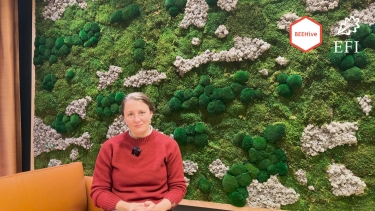New EFI study launched - Maintaining and enhancing forest biodiversity in Europe

Biodiversity loss has been globally recognised as a major threat to ecological and socio-economic stability. The forest ecosystems of Europe, which include both natural and managed forests, provide habitats for numerous species and are havens for much of Europe’s biodiversity.
In a comprehensive new European Forest Institute study, a multidisciplinary team of 13 authors from 10 countries have analysed how to effectively maintain and enhance forest biodiversity in Europe:
- Forest biodiversity monitoring is key. Increased conservation and management of European forest biodiversity starts with effective monitoring.
- Threats to forest biodiversity can be distinguished between ‘external’ threats that are beyond the direct influence of forest owners and managers (e.g. atmospheric pollution, climate change, biological invasions, land use change) and ‘internal’ threats that are directly related to forest management practices.
- More stringent conservation measures are urgently required for forests that are home to species under threat, e.g. primary, old-growth and ancient forests.
- Hands-on nature-positive management is possible in every forest managed for wood production, including plantation forests.
- Ecosystem management approaches, including variants of close-to-nature forest management, need to be developed further to embrace disturbances and support biodiversity at different scales, from genes to landscapes.
- On a landscape scale, a variation of forest management approaches and intensity, e.g. Triad management is a promising strategy to conserve a broad range of biodiversity while also achieving other important forest management objectives.
- Conserving and increasing biodiversity is a shared task that needs to be undertaken ambitiously by European forest managers and owners, public and private institutions, as well as the general public. It requires broad institutional and financial support.
The study explores thoroughly how forest biodiversity is more than just a mixture of species. It concerns gene pools, structural and functional diversity as well as scale aspects that range from a single tree to entire regions. Forest managers and policymakers can both take action to maintain, but also enhance forest biodiversity in many forms.
Policymakers should note that a considerable time lag between biodiversity responses to new policies has to be taken into account, given the slow pace of forest development and related management interventions. Long-term commitment and societal support for biodiversity policy is therefore a must. The mix of tailor-made financial and other instruments needs to be expanded to successfully secure Europe’s biodiversity heritage. Market-driven instruments such as reverse auctions and biodiversity offsets are still underdeveloped.
EFI’s Assistant Director and editor of the series, Helga Pülzl said: “This comprehensive and interdisciplinary study based on latest available knowledge on forest biodiversity, sets a new and important milestone, which we were looking for.” Lead author and professor of forest ecology and management at KU Leuven, Bart Muys added: “There are simple methods to boost biodiversity in any forest in Europe, also those intensively managed for wood production. It will contribute to stability, productivity and above all more manager’s satisfaction while serving the beauty of nature.”
More information
The study is published on 30 May 2022, and is freely available to download.
Recommended citation:
Muys, B., Angelstam, P., Bauhus, J., Bouriaud, L., Jactel, H., Kraigher, H., Müller, J., Pettorelli, N., Pötzelsberger, E., Primmer, E., Svoboda, M., Thorsen, B.J., Van Meerbeek, K. 2022. Forest Biodiversity in Europe. From Science to Policy 13. European Forest Institute.
This work and publication has been financed by EFI’s Multi-Donor Trust Fund for policy support, which is supported by the governments of Austria, Czech Republic, Finland, Germany, Ireland, Italy, Lithuania, Norway, Slovenia, Spain and Sweden.


